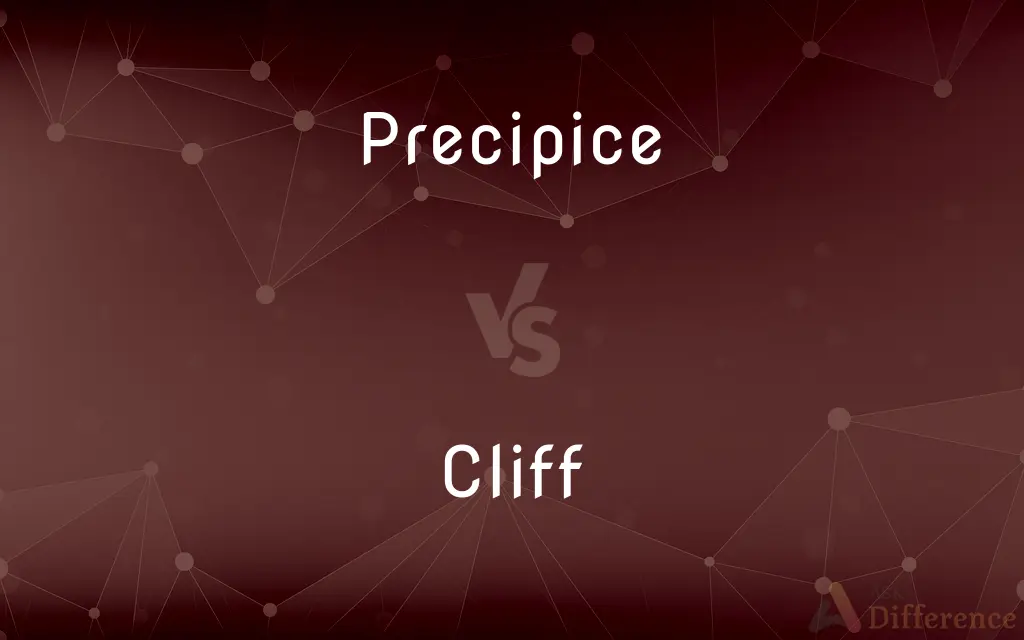Precipice vs. Cliff — What's the Difference?
Edited by Tayyaba Rehman — By Urooj Arif — Updated on April 3, 2024
A precipice is a very steep or vertical face of rock, often seen as more dangerous or dramatic, while a cliff is any steep rock face, especially at a coast or along a river.

Difference Between Precipice and Cliff
Table of Contents
ADVERTISEMENT
Key Differences
A precipice implies an extremely steep or overhanging place, often invoking a sense of danger or a dramatic drop, making it synonymous with perilous situations. On the other hand, a cliff refers more generally to any high, steep face of rock, whether inland or along coastal areas, and does not inherently suggest the same level of danger or dramatic steepness.
Precipices are often characterized by their sheer drops and the threat they pose to safety, commonly used in literature and speech to symbolize critical or hazardous situations. Conversely, cliffs, while they can be dangerous, are also admired for their scenic beauty and serve as popular spots for activities like hiking and bird watching, highlighting their less perilous nature.
The term "precipice" is frequently employed in a metaphorical sense to describe a situation where one is on the brink of a significant and potentially disastrous decision or change. Cliffs, while they may be used metaphorically, are more often described in a literal sense, focusing on their geographical and recreational significance.
Moreover, the choice between using "precipice" or "cliff" can depend on the context and the speaker's intention to emphasize the steepness or the risk involved. While both terms describe natural formations with steep faces, the former is more likely to be used when the element of extreme risk or verticality is highlighted.
Comparison Chart
Definition
A very steep, vertical, or overhanging face of rock, often associated with danger.
A high, steep face of rock, regardless of location.
ADVERTISEMENT
Connotation
Implies greater danger and steepness.
More neutral, focusing on geographical features.
Usage
Often used metaphorically to describe dangerous or critical situations.
Described both literally for geography and metaphorically, but with less emphasis on danger.
Activities
Rarely associated with recreational activities due to the danger.
Popular for hiking, bird watching, and scenic views.
Example Locations
Could be part of a mountain range or an isolated feature.
Found along coastlines, riverbanks, and in mountainous regions.
Compare with Definitions
Precipice
Often used to describe critical situations.
The company was on the precipice of bankruptcy before the new CEO turned it around.
Cliff
Can be a landmark for navigation.
Sailors used the distinctive shape of the cliff as a guide to enter the harbor.
Precipice
A steep or vertical face of rock, perilous in nature.
The mountain climber approached the precipice with caution, knowing a misstep could be fatal.
Cliff
Popular for recreational activities.
The cliffs along the coast were a favorite spot for bird watchers.
Precipice
Symbolizes extreme situations or decisions.
The decision to quit his job and travel the world put him on a personal precipice.
Cliff
A high, steep rock face, often along the coast.
The lighthouse stood atop a cliff, overlooking the ocean waves crashing below.
Precipice
Characterized by a sudden drop.
Standing at the edge of the precipice, she felt a thrill at the sheer drop below.
Cliff
Part of the natural habitat for various wildlife.
The cliffs were home to a colony of rare seabirds, undisturbed by human activity.
Precipice
Associated with dramatic landscape features.
The hikers paused at the precipice, taking in the breathtaking view of the valley.
Cliff
Features in scenic photography and art.
His photograph of the sunrise over the cliffs won a prestigious award.
Precipice
A very steep rock face or cliff, especially a tall one
We swerved toward the edge of the precipice
Cliff
In geography and geology, a cliff is an area of rock which has a general angle defined by the vertical, or nearly vertical. Cliffs are formed by the processes of weathering and erosion, with the effect of gravity.
Precipice
An overhanging or extremely steep mass of rock, such as a crag or the face of a cliff.
Cliff
A steep rock face, especially at the edge of the sea
A coast path along the top of rugged cliffs
Precipice
The brink of a dangerous or disastrous situation
On the precipice of defeat.
Cliff
A high, steep, or overhanging face of rock.
Precipice
A very steep cliff.
Cliff
A vertical (or nearly vertical) rock face.
Precipice
(figurative) The brink of a dangerous situation.
To stand on a precipice
Cliff
(figurative) A point where something abruptly fails or decreases in value etc.
Precipice
(obsolete) A headlong fall or descent.
Cliff
A high, steep rock; a precipice.
Precipice
A sudden or headlong fall.
Cliff
See Clef.
Precipice
A headlong steep; a very steep, perpendicular, or overhanging place; an abrupt declivity; a cliff.
Where wealth like fruit on precipices grew.
Cliff
A steep high face of rock;
He stood on a high cliff overlooking the town
A steep drop
Precipice
A very steep cliff
Common Curiosities
Is the term "precipice" used outside of describing natural landscapes?
Yes, "precipice" is frequently used metaphorically to describe situations of great risk or critical decisions.
What is the main difference between a precipice and a cliff?
The main difference lies in the degree of steepness and danger, with a precipice being more vertical and perilous.
Are precipices found only in mountainous areas?
While often found in mountains, precipices can also occur in any terrain where there are steep drops, including coastal areas.
Are activities like climbing allowed on precipices?
Climbing on precipices can be extremely dangerous and is often restricted; climbers should always check local regulations.
How do cliffs affect local ecosystems?
Cliffs can provide unique habitats for plants and animals, offering nesting sites for birds and refuge for plants adapted to harsh conditions.
Can any cliff be called a precipice?
Not all cliffs are precipices; only those that are exceptionally steep and dangerous qualify as precipices.
Can cliffs be safe to visit?
Many cliffs are safe to visit, especially those in parks or coastal areas with safety barriers and designated viewing areas.
What causes the formation of cliffs and precipices?
They are formed by erosional processes such as the action of waves, wind, and ice, or by tectonic activity that fractures the earth's crust.
How do climbers prepare for ascents on precipices?
Climbers prepare with rigorous training, proper equipment, and thorough knowledge of the terrain to tackle the challenges of precipices.
Are there any famous precipices known for their beauty rather than danger?
Yes, some precipices are renowned for their dramatic beauty, attracting photographers and nature enthusiasts despite their dangers.
Do all cliffs offer scenic views?
While many cliffs are known for their scenic views, the actual view can vary depending on the location and surrounding landscape.
How do safety measures differ between cliffs and precipices?
Safety measures, such as barriers and warning signs, are more critical at precipices due to the greater danger they pose.
Can the erosion of a cliff turn it into a precipice?
Over time, erosion can increase the steepness of a cliff, potentially creating a precipice if the slope becomes nearly vertical.
What role do cliffs play in coastal defense?
Cliffs can act as natural barriers to sea erosion, protecting inland areas from waves and storm surges.
What is the significance of cliffs in cultural and historical contexts?
Cliffs have served as natural fortifications, sacred sites, and inspiration for artists and writers throughout history, reflecting their cultural and historical significance.
Share Your Discovery

Previous Comparison
Flu vs. Lurgy
Next Comparison
Surgery vs. ProcedureAuthor Spotlight
Written by
Urooj ArifUrooj is a skilled content writer at Ask Difference, known for her exceptional ability to simplify complex topics into engaging and informative content. With a passion for research and a flair for clear, concise writing, she consistently delivers articles that resonate with our diverse audience.
Edited by
Tayyaba RehmanTayyaba Rehman is a distinguished writer, currently serving as a primary contributor to askdifference.com. As a researcher in semantics and etymology, Tayyaba's passion for the complexity of languages and their distinctions has found a perfect home on the platform. Tayyaba delves into the intricacies of language, distinguishing between commonly confused words and phrases, thereby providing clarity for readers worldwide.














































